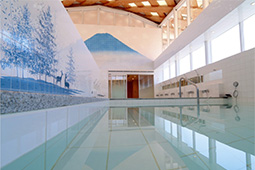February 2022
- English
- 日本語
Onagawa Station, a Symbol of Recovery from the Great East Japan Earthquake

The Onagawa Station building following its opening in March 2015 
The Seapal-Pier Onagawa commercial complex and sea beyond, viewed from Onagawa Station

Onagawa Station in 2007, before the Great East Japan Earthquake of 2011 
A bath at Onagawa Onsen Yupo’po in the Onagawa Station building featuring beautiful tile art on the walls 
Aerial photo of central Onagawa Town. The building with the white roof in the middle is Onagawa Station. A brick road extends straight from the station to the sea.

Onagawa Station in Onagawa Town, Miyagi Prefecture, was severely damaged by the Great East Japan Earthquake of March 2011. It was rebuilt four years later and has become one of the symbols of the town’s reconstruction.

On March 11, 2011, a magnitude 9.0 earthquake occurred in the Pacific Ocean off northeastern Japan. Shortly afterwards, a huge tsunami hit the Pacific coast of the Tohoku and Kanto regions, causing severe damage in many locations.
One of the hardest-hit areas was Onagawa Town in Miyagi Prefecture. At the time, Onagawa Town was a port town with a lively fishery and seafood processing industry, home to about 10,000 people living mainly around Onagawa Port. However, a tsunami about 15 meters high destroyed most of the town and left more than 800 people dead or missing.
Onagawa Station on the JR Ishinomaki Line, about 200 meters away from Onagawa Port, was a small station with a single-story building, but it played an important role for tourists visiting the area and residents commuting to work and school. Moreover, the town hall and other public facilities were located near the station, making it a central location for the town. Yet, the station building was washed away without a trace by the tsunami. Also lost was the hot spring facility adjacent to the station, Onagawa Onsen Yupo’po, which was a popular place with locals and tourists alike.

Six months after the earthquake and tsunami disaster, Onagawa Town Office had come up with a recovery plan and reconstruction began. Onagawa Town aims to be a safe and vibrant town with the station as its center, and so plans were developed to raise the land around Onagawa Station further above sea level and to concentrate public, commercial and tourist facilities there.
In March 2015, Onagawa Station opened as a symbol of the new town to coincide with the restoration of the entire Ishinomaki Line. To prevent damage from any future tsunami, the reconstructed station is located about 200 meters further inland than the previous location and on land that has been raised by nine meters. The three-story station building was designed by world-renowned architect Ban Shigeru. The large white roof was designed to evoke the image of a black-tailed gull flapping its wings. The second floor houses Onagawa Onsen Yupo’po, its bathhouse walls decorated with beautiful tile art recreating paintings of Mt. Fuji and deer in the forest by world-renowned Japanese artist Senju Hiroshi and others. The designs are intended to reflect visions of the bright future of Onagawa Town. From the observation deck on the third floor, visitors can look out over Onagawa Town and Onagawa Port, and in winter watch the sun rising from the sea. A footbath in front of the station building can be enjoyed for free. (Onagawa Onsen Yupo’po is currently closed for repairs [February 2022].)

“When I first visited Onagawa Station in 2007, there were so many buildings around the station that you couldn’t see the sea from the station or from the platform,” says Muramatsu Taku, who works for a company in Tokyo and spends his days off traveling to stations across Japan that are situated close to the sea. He presents his photographs and observations on his website, “Stations from Where You Can See the Sea.”
Muramatsu visited Onagawa Station again in 2017, ten years after his first visit. Following the post-earthquake reconstruction, the scenery had changed completely. When leaving through the station’s ticket gate, he proceeded down a straight brick road leading straight to Onagawa Bay, with the sea appearing at the end of the road’s gentle downhill slope. The road passes by a commercial complex called Seapal-Pier Onagawa where there are restaurants and stores selling household goods and other things, and which he found busy with tourists and local residents.

“Although the devastation caused by the tsunami far exceeded the imagination, I felt sad that nothing looks like it used to,” says Muramatsu. “But at the same time, I was very happy to see the bustle of the town and am looking forward to seeing how it develops in the future.”
Town development centered on the station has opened the future for Onagawa Town.

